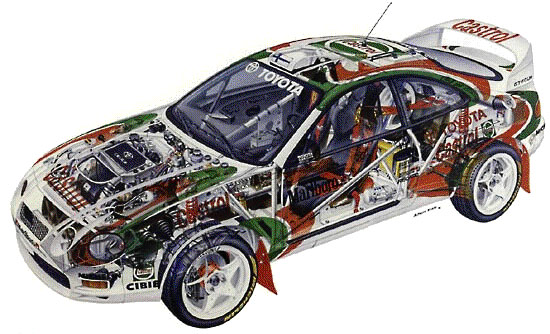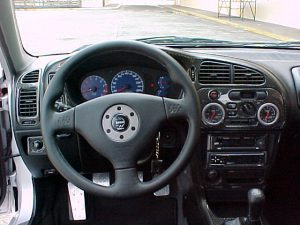Toyota Celica history and technical infos
Toyota was the first Japanese company that tried, and later succeeded, to beat European manufacturers in the World Rally Championship. Their Celica has gone through many mutations since it first took part in world class rallying back in 1988 in the Tour de Corse rally. As usual Japanese manufacturers come up with a new version of their cars every two years. This didn’t seem to cause too many problems to Toyota Team Europe, the team that prepares the racing cars. There was always a period of adapting a new model to rally racing but this usually took less than three months.
The commercial versions of the Celica went through a number of updates starting with the original ST165 (1987-1989) going to the ST185 (the bio-design car, 1990-1992) and lastly the ST205 (1993-1999). The competition cars followed this evolution closely.
The first 4WD version (ST165) suffered mainly from heat problems not having enough air circulating in the engine compartment. This problem was partially fixed in the ST185 with the addition of an engine bonnet vent. The ST205 was the most accomplished version, aerodynamically speaking.

The Group A version of the Celica (ST205)
The Celica has been a hard to beat contender ever since its introduction in the WRC when it raced against the Lancia Integrale in 1989-90. Toyota won 38 WRC rallies and 2 WRC Championships (’93 and ’94) with it.
The Toyota team was promised to success up to the Catalunya rally in 1995 when an FIA commissioner discovered a weird device in Didier Auriol‘s Celica ST205.
To limit the horsepower in rally cars the FIA has regulated the use of a turbo restrictor. This is device, resembling a tube, with a regulations specified dimensions fits in the turbocharger’s air intake to limit the air flow and consequently the engine’s output. Toyota engineers had mounted the restrictor in a way that it would slightly move from its original position, allowing more air into the turbocharger, when the car was running. This of course was prohibited and as a consequence Toyota was excluded from the World Rally Championship. Too bad for their drivers, Juha Kankkunen, Didier Auriol and Armin Schwarz at the time, who declared they knew nothing whatsoever about the presence of such a device in their cars. No one ever found out whether the device came from Toyota Japan or from Toyota Team Europe. Either way each party must have known about its presence.
That was a really sad moment for the rally racing world. Especially so because Toyota was one of the most (if not the most) innovating teams around. They, first, introduced hydro-electronic differentials, they introduced the A.L.S. (a.k.a. bang-bang) engine management system as well as the “joystick” gear change interface (in the Corolla WRC) among many other innovations.
Anyway back to the car now, the Celica GTFour was based on the production Celica versions and looked almost exactly like one. The latest street version of the car contained some very fine engineering. The 2 liter 4 in-line engine was derived from the atmospheric (non turbocharged) version and delivered anywhere from 220 Bhp in its first versions to 242 Bhp in the latest street GTFour. Turbo lag time was kept within reason due to the use of a small, in-house, CT-20 turbocharger. Many technical innovations where present in this engine and car. You may note among others:
- An electronically controlled turbocharger (Toyota Computer Controlled System) which also handled injection and ignition
- Specially shaped intake and outlet tubes
- A very cleverly designed two-way catalytic converter which reduced back pressure on the turbo
- A water to air intercooler whose water was cooled in an extra water cooler
- Increased water and oil flows compared to older versions of the engine
- The Fresh Air Intake System, a device producing almost the same effects as an A.L.S. (this was unfortunately disconnected in street cars due to excessive exhaust tube stress and noise)
- 4 piston aluminum brake calipers in the front wheels and 315!mm vented brake discs
- Many parts of the body where in aluminum including the engine bonnet, parts of the chassis, etc.
The specification of the street version ST205 Celica can be found here. As you might have already guessed this was some car. Toyota delivered more in the Celica GTFour than one could hope for. The Torsen (which stands for Torque Sensing) rear differential was a very good surprise too. Previously used in the Lancia Integrale and the Audi Quattro this device generates extra costs to the overall price of the car. No wonder the Celica GTFour was the most expensive street versions of the homologation specials. The one problem the street Celica version was suffering from was its weight. A laden weight of around 1450Kg is way too high for a “sports” car and generates important inertia-induced parasitic movements. This fact influenced badly the car’s handling abilities.
Even more technology was packed in the competition version of the Celica GTFour. You see Toyota really wanted to win the WRC title. Rally used to be a very important part in Toyota’s marketing budget at the time. The team hired two of the most talented rally drivers ever: Juha Kankkunen and Carlos Sainz and invested huge amounts of energy and money to beat the Lancia Integrale, at first, then the Ford Escort RS Cosworth and finally the Subaru Impreza. They managed to succeed.
The latest Group A version of the Celica GTFour was a very balanced car to drive. The factory cars used XTrac gear boxes and where equipped with a system called Hydraulic Torque Sensor. This system continuously varied the part of engine torque sent to the front or rear wheels depending on whether the car was accelerating or braking. As usual in rally cars all chassis where reinforced and many more welding points applied than in normal, street, cars.
The biggest disadvantages of the Celica GT4 when compared to other successful Group A rally cars, were its dimensions and the driver’s limited visibility. Most Celica drivers used to complain saying they were feeling as if they were sitting in a Porsche when driving the car. Ove Anderson (an ex-rally driver himself), Toyota Team Europe manager, spent many years trying to convince Toyota Japan that the Corolla class of vehicles was much more suited to rallying. With the new WRC car regulations in effect since January 97 he finally succeeded to develop a WRC version of the Corolla.

